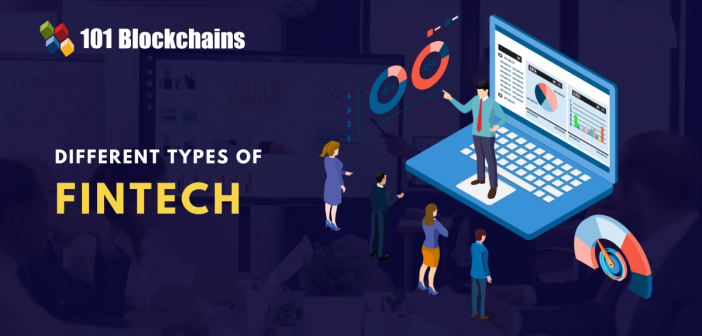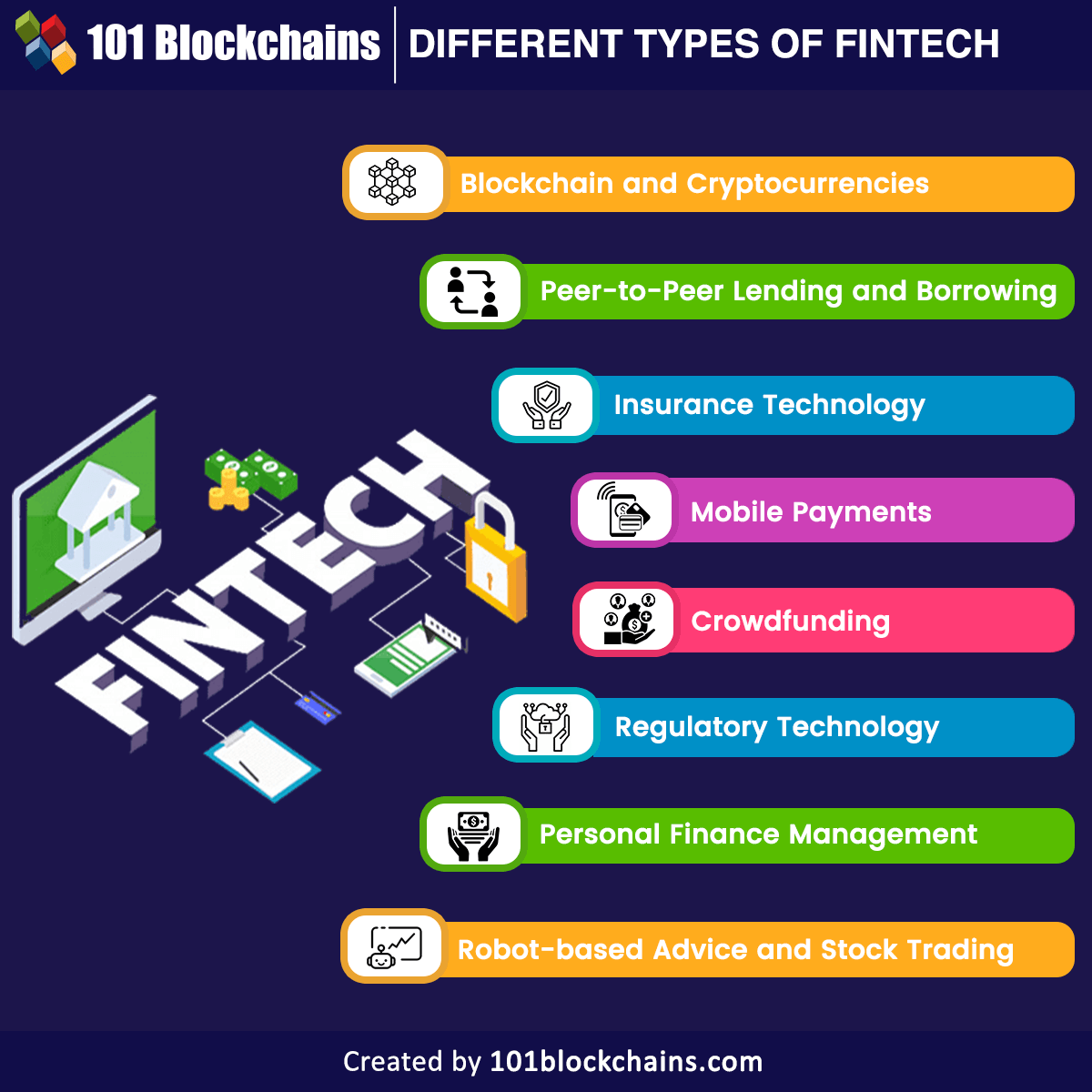Learn how blockchain truly works, master key definitions, and uncover what makes smart contracts so "smart." Dive into the fundamentals, gain valuable insights, and start your blockchain journey today!

- FinTech
Georgia Weston
- on December 07, 2022
What are the Different Types of Fintech?
Fintech is one of the prominent highlights among different technology trends which have been gaining attention worldwide. Many of you would assume that fintech is a new-age transformative technology that could change the definition of financial services altogether. While the assumption is valid to an extent, fintech is not some alien technology to users of financial services.
The curiosity regarding different fintech types and examples has contributed to confusion in understanding what fintech actually means. However, fintech is practically the use of technology to make finance better. For example, automation of customer service processes can help financial services customers in dealing with common roadblocks in different services. The value advantages of fintech, alongside the rapid growth in a number of fintech startups and companies, prove that the fintech industry would post formidable numbers for growth.
Why should you think about the types of financial technology before diving into the intricacies of fintech? The overview of different fintech variants and fintech examples could offer indications of the ways in which fintech transforms financial services. The following discussion offers you a description of the different examples and types of fintech alongside an explanation of their value.

Why Should You Care about Fintech?
The interest in financial technology or fintech types has become a priority for aspiring professionals in recent times. Fintech refers to financial technology and encompasses almost any technology that you can integrate with finance services. It can be defined as the collection of new technologies developed to expand the scope of financial services.
Most important of all, the domain of fintech includes software, cloud applications, mobile and web applications, dedicated organizations, and digital extensions of legacy banking services. The credit cards introduced in the 1950s offer a prominent example of how fintech has been introducing credible improvements in financial services.
The multiple applications of fintech have led to the rise of fintech categories, which can introduce plausible improvements for users. Interestingly, the users of fintech include not only individual customers but also startups, small businesses, and well-established corporations which want to leverage fintech.
In addition, government institutions can also leverage fintech to achieve desired value advantages. Before you take a look at the different fintech types, you might have doubts about the impact of fintech. Has fintech registered a formidable impact on the world of financial services leading to its categorization into multiple variants?
Develop in-depth knowledge of fintech concepts and become a part of the advancements in finance with elementary Fintech Flashcards
The Fintech Effect on Numbers
Fintech has obviously developed as a formidable trend in the domain of technology recently. On the other hand, it is not an overnight phenomenon, as the first examples of financial technology are visible in the use of credit cards and ATMs. The introduction of mobile banking enabled the large-scale use of fintech. For example, almost 5% of the global app downloads in 2019 account for financial applications.
Restrictions due to the global pandemic played a vital role in driving the adoption of different types of financial technology across different industries. The pandemic spurred a rapid boost in online booking, micro-loans, and virtual transactions to ensure efficiency in financial management. Investments in various types of fintech services reached more than $35 billion in 2019. As of now, the funding for financial technology applications has reached almost $25 billion from different funding deals.
Furthermore, the causes for driving growth in fintech focus on the rise in the volume of digital payments. The transaction value in digital payments is projected to reach $9.46 trillion in 2023. Therefore, fintech categories can definitely capitalize on the new trends in consumer behavior.
Subsequently, many financial services organizations have stepped up for the implementation of the latest and innovative technologies for improving user experiences. The fintech sector is all set to reach the $310 billion mark by the end of 2022, thereby suggesting a promising future for the domain.
Want to become familiar with Fintech and its working? Enroll Now in Fintech Fundamentals Course!
Types of Fintech
The obvious response to “What are the different types of fintech?” draws attention to the working of fintech. It is important to note that fintech is a broad term encompassing various concepts, technologies, products, and services. At the same time, the consistent evolution of new technologies in fintech opens up the doors for new types of fintech.
You can develop a clear impression of the different fintech variants by identifying how different technologies are used for transforming financial services.
Here is an outline of the popular fintech variants with practical examples for a comprehensive understanding of financial technologies.

Please include attribution to 101blockchains.com with this graphic. <a href='https://101blockchains.com/blockchain-infographics/'> <img src='https://101blockchains.com/wp-content/uploads/2022/11/types-of-fintech-1-1.png' alt='different type of fintech='0' /> </a>
-
Blockchain and Cryptocurrencies
The first entry among the popular types of financial technology would refer to blockchain technology and cryptocurrencies. Blockchain could enable peer-to-peer transactions alongside the power of smart contracts and consensus algorithms for setting new precedents for the growth of financial services. The advantages of decentralized and immutable ledgers of financial transactions on blockchain with cryptocurrencies or crypto tokens can introduce many significant improvements in financial services.
Most important of all, applications of blockchain in the fintech sector could drive plausible chances for financial innovation. For example, decentralized storage of transaction history prevents the risks of counterfeit data and double spending problems. With more than 80 million crypto wallet owners all over the world, the impact of blockchain on the democratization of financial services is clearly evident. One of the notable examples of blockchain-based fintech projects refers to we.trade, an enterprise-grade trade finance platform by IBM.
Cryptocurrencies, based on blockchain technology, are also another notable example of fintech types with a formidable impact on financial services. Blockchain could help in enabling better privacy, security, and transparency in tracking financial transactions throughout their entire lifespan. Cryptocurrencies could utilize the traits of blockchain to ensure better monitoring and control over their assets. Examples of the popularity of Bitcoin, Ethereum, stablecoins, and many other crypto assets have proved how cryptocurrencies are integral to the future of fintech.
Build your identity as a certified blockchain expert with 101 Blockchains’ Blockchain Certifications designed to provide enhanced career prospects.
-
Regulatory Technology
Another notable response to “What are the different types of fintech?” would focus on regulatory technology. According to the Financial Conduct Authority, regulatory technology is a subclass of fintech focused on technology that could enable efficient delivery of regulatory obligations. Regulatory technology or RegTech could utilize cutting-edge technology to improve compliance alongside facilitating the introduction of simple, cost-effective, secure, and easy-to-understand regulations.
New regulatory frameworks are an obvious necessity in a consistently reforming financial landscape trying to catch up with the latest innovations and advancements. As one of the notable fintech categories, RegTech aims at standardization and promotion of transparency in regulatory processes.
Furthermore, regulatory technology in fintech also focuses on the automation of the complete compliance system. RegTech could offer the foundation for various regulatory solutions such as risk management, compliance management, regulatory reporting, and transaction monitoring. Some examples of RegTech platforms include Continuity, Regis-TR and Provenir.
Aspiring to make a lucrative career as a Fintech expert but not sure how? Check the detailed guide Now on How To Become A Fintech Expert
-
Insurance Technology
The next prominent addition among finance technology fintech types would refer to insurance technology or InsurTech. The growth of digital financial service ecosystems has enabled flexibility for developing insurance solutions with high value to improve user experience. Insurers are trying to use fintech variants for the integration of smartphone apps, AI, IoT, machine learning, and many other technologies to improve the value of insurance services.
Fintech could enable formidable improvements in insurance services, such as an easier collection of insurance details on smartphones. Similarly, user-friendly apps could play a crucial role in ensuring easier management of coverage. Many providers have been working on telematics to improve core insurance products and streamline coverage. At the same time, InsurTech also changes the perspective of users on insurance products with many value advantages.
-
Mobile Payments
One of the common answers to “What are the different types of fintech?” would also point to mobile payment systems. Some of you must have used popular applications such as PayPal, Apple Pay, Google Pay, Venmo, or Google Play for sending or receiving payments.
The impact of a global pandemic turned the whole world’s attention toward possibilities for cashless transactions. The continuously declining relevance of cash in the post-pandemic era has also called for organizations in every industry to think about payments. Are mobile payment apps trustworthy?
Depending on the individual functionalities, mobile payments have different value propositions. Popular mobile payment solutions such as Google Pay and Venmo have gained a substantial number of users. For example, Venmo has more than 65 million daily users, indicating the trust of users in the app.
Build your identity as a certified blockchain expert with 101 Blockchains’ Blockchain Certifications designed to provide enhanced career prospects.
-
Peer-to-Peer Lending and Borrowing
The introduction of financial technology has also presented viable prospects for the transformation of lending and borrowing systems. Fintech has been a crucial player in simplification of the approaches people follow for borrowing money. The types of financial technology used for transforming financial services like lending have introduced P2P lending protocols.
Any individual could access these platforms and borrow loans anytime. Interestingly, users of such fintech solutions would also find flexible opportunities for evaluation of a borrower’s credit readiness. At the same time, the implementation of fintech also removes the need for attending any office or bank to obtain loans.
P2P lending protocols rely on the power of DeFi to enable seamless access to financial services and improve user experience. For example, Compound and Aave are popular lending protocols based on DeFi. Another popular example of lending applications in fintech types would refer to Credit Karma.
It is a renowned personal finance provider with more than 110 million users in the USA. The app has developed a reputation for offering free and trustworthy credit score reports. Users can also avail of productive tools for identity and credit monitoring, loan shopping, and feasible credit card recommendations.
Want to learn and understand the scope and purpose of DeFi? Enroll Now in Introduction to DeFi- Decentralized Finance Course
-
Personal Finance Management
Personal finance management is also another proven response to “What are the different types of fintech?” with popular examples. It is a unique and personalized category of fintech focused on enhancing wealth management and retail investment practices. Personal finance technology, or WealthTech, is a popular and value-based variant of fintech, which can improve and facilitate operations with better efficiency and automation.
The primary goal of WealthTech focuses on streamlining the investment process, which can help investors in easier management of investment portfolios. One of the notable examples of personal finance management solutions among fintech variants is Monie, a personal finance application for the Egyptian market.
-
Crowdfunding
The crowdfunding market has the potential for steady growth in the forecast period from 2021 to 2026, with a CAGR of more than 16%. Crowdfunding platforms have removed the need to visit a bank or pitch ideas before venture capitalists to obtain loans or funding for projects.
The outline of different fintech categories would also emphasize the new methods for raising capital by employing innovative improvements. Crowdfunding fintech services could offer the ideal opportunity for micro and small enterprises to discover investors for their projects.
Start learning Fintech with World’s first Fintech Skill Path with quality resources tailored by industry experts Now!
-
Robot-based Advice and Stock Trading
The most formidable example of financial technology fintech types would refer to robot-based advisors. You must have learned about the importance of AI and machine learning in the burgeoning fintech industry. Robot-based advisors are applications powered by AI and ML for offering recommendations regarding financial decisions. As a result, financial service users could figure out an alternative to hiring an expert for financial advice. Most important of all, your robot advisor would never take breaks and would provide round-the-clock data analysis capabilities.
Similarly, the outline of different types of financial technology also includes references to stock trading apps. Stock trading apps are useful tools for investors to conduct desired transactions directly from their smartphones. The power of AI and ML could help in capitalizing on meaningful insights from humongous piles of data. At the same time, the use of blockchain could also streamline the security of the personal and financial data of investors.
Want to learn about the fundamentals of AI and Fintech? Enroll Now in AI And Fintech Masterclass!
Final Words
The overview of answers to “What are the different types of fintech?” show that fintech has indeed come a long way from credit cards in the 1950s. Mobile apps, robot-based financial advice, and chatbots offering customer support are a few examples of the transformation of financial services.
However, it is also important to note that each fintech variant serves a distinct purpose in the broader ecosystem. The goal of fintech to make financial services easier for organizations and consumers would fuel many innovative advancements in this sector. Keep an eye out for the latest trends in fintech and start learning more about other technologies which can affect fintech now.
*Disclaimer: The article should not be taken as, and is not intended to provide any investment advice. Claims made in this article do not constitute investment advice and should not be taken as such. 101 Blockchains shall not be responsible for any loss sustained by any person who relies on this article. Do your own research!






